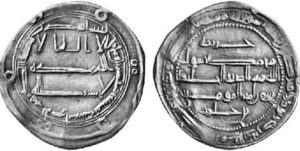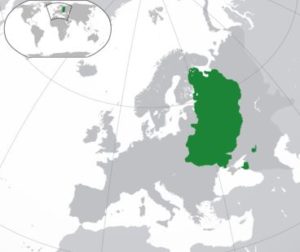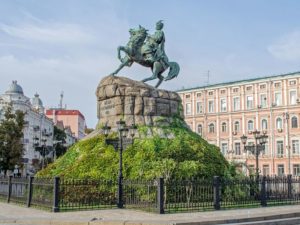At the turn of the 8th century, a new power arose in the lands between the Black and Caspian Seas. This power was the Turkic people known as the Khazars. Around 740 CE, King Bulan of the Khazars made a fateful decision to convert to Judaism. Many in his royal family converted with him. The Khazar kingdom continued to spread far and wide, and its coins (bearing the inscription “Moses is the [True] Prophet of God”) have been uncovered by archaeologists as far as England to the west and China to the east.
 In their rapid expansion, one of the new towns that the Khazars established was on the Dnieper River, and they called the town “Sambat”. Historians are uncertain what this word means or where it comes from. Considering the Jewish background of the Khazar kings, it is quite likely that the name comes from the legendary Jewish river, the Sambatyon. It was long believed that the Lost Tribes of Israel—exiled back in the middle of the first millennium BCE—had been resettled in distant lands past the mysterious Sambatyon River. The name “Sambatyon” itself comes from “Shabbat”, as it was said the Sambatyon River would only be calm on the Sabbath, when it could not be traversed. It is possible that the Khazars who founded this town were Jews who believed the Dnieper was the Sambatyon. Or it could be that they were Jewish settlers who stopped there one Shabbat to rest, and realized it was a good place to stay, hence the name. Whatever the case, by the 10th century, Sambat was better-known by another name: Kiev.
In their rapid expansion, one of the new towns that the Khazars established was on the Dnieper River, and they called the town “Sambat”. Historians are uncertain what this word means or where it comes from. Considering the Jewish background of the Khazar kings, it is quite likely that the name comes from the legendary Jewish river, the Sambatyon. It was long believed that the Lost Tribes of Israel—exiled back in the middle of the first millennium BCE—had been resettled in distant lands past the mysterious Sambatyon River. The name “Sambatyon” itself comes from “Shabbat”, as it was said the Sambatyon River would only be calm on the Sabbath, when it could not be traversed. It is possible that the Khazars who founded this town were Jews who believed the Dnieper was the Sambatyon. Or it could be that they were Jewish settlers who stopped there one Shabbat to rest, and realized it was a good place to stay, hence the name. Whatever the case, by the 10th century, Sambat was better-known by another name: Kiev.
The Byzantine king Constantine VII Porphyrogenitus (r. 913-959) wrote in his De Administrando Imperio that three Khazar brothers named Kyi, Shchek, and Khoriv established “the stronghold of Kyiv, also called Sambatas.” For some time afterwards, Arabic sources refer to the city as Zanbat. In Russian history, though, the region is always referred to as Kievskaya Rus’, the very birthplace of “Mother Russia”.
Rise of the Third Rome
In the middle of the 8th century CE, a group of Slavic settlers founded a new city, Novgorod (literally “new city”). However, they could not defend themselves against raids and attacks from surrounding tribes. In 862, they invited the Scandinavian king Rurik to take control. He did, and turned Novgorod into a powerful city, conquering neighbouring towns and tribes. His son, King Oleg, continued the expansion and, in 882, conquered Kiev. The growing kingdom was called Rus’, either in honour of the founder Rurik, or from rootsi, his Viking “rowers” that first came across the Sea to these lands. The name later gave rise to beleya-rus’, “White Russia”, ie. Belarus; to Ruthenia; and to Rossiya, Russia itself.
The Rurik Dynasty continued to wage war with the Khazars to the south for decades. The famed “Schechter Letter”, one of the greatest historical finds for understanding Khazaria, describes the battles fought against the Rus by Khazarian kings and generals with names like Benjamin, Aaron II, and even Pesach! By the end of the 10th century, Khazaria had all but disappeared. Some have posited that its many Jews fled north and west, giving rise to the Ashkenazi Jewish community (for why this is incorrect, read here). Others state that Khazaria continued to exist into the 1200s, until the Mongol invasion of the region that formally put an end to many other political entities.
The Mongols wrecked absolute havoc in the lands of the Rus’, raping and pillaging, burning down cities, and exacting vast tributes. They were called “Tatars”, from the Greek Tartarus, “hell”. By the 14th century, a new Rus’ city had risen to take up the mantle of holding back the Tatars. This city was Moscow. By the time of King Ivan III (r. 1462-1505), the Tatars had been defeated, and Ivan became the “Grand Prince of All Rus’”, ruling from his magnificent capital, Moscow. His territory stretched vast distances, and the west-most region bordering Poland was sometimes called Ukraina, literally the “edge” or “borderland”.
It was during the reign of Ivan III that, across the Black Sea, the Ottoman Turks put an end to the Byzantine Roman Empire for good. (They had famously conquered Constantinople back in 1453, making it “Istanbul”). Henceforth, many Orthodox Christians identified illustrious Moscow as the “New Rome” or “Third Rome”, and the Russian royal family very much agreed. In fact, Ivan IV (“the Terrible”) was no longer called “grand prince”, but now had a new title: Caesar, or as pronounced in Russian, czar. That Russia became the “Third Rome” happens to be of great significance to Judaism, for our Sages had famously predicted that Mashiach would come after the fall of the “Third Rome”, but before the rise of a “Fourth Rome”. (For more on this, see here.)
The Pale of Settlement
In 1332, King Casimir III of Poland opened up the doors for Jewish immigrants, and gained a reputation as a philo-Semite. When Jews were expelled from Spain in 1492, many of them journeyed to tolerant Poland. By the end of the 16th century, Poland was referred to as a “Jewish Haven”, and some historians estimate that as much as three-quarters of the world’s Jews lived in Polish territory at the time. At its height, Poland controlled much of what is today Belarus and Ukraine. They encouraged Jews to settle in these territories, and often employed them as tax collectors and administrators. Not surprisingly, this drew the ire of the locals. In 1648, the Ukrainian Cossacks, together with the Crimean Tatars, rebelled against Polish rule. They massacred Poles, Catholics and, of course, Jews. It is estimated that about 100,000 Jews were slaughtered by Bogdan Khmelnytsky and his Cossacks. Nonetheless, Khmelnytsky is considered to this day a revered “founding father” of Ukraine.
By the late 1700s, Poland would lose all of the eastern territories back to the Russian Empire. The Russians severely restricted the Jews, and decided to confine them to the “Pale of Settlement”—rural areas mainly in what is now Belarus and Ukraine. Jews generally could not live in Russia proper, or in the main cities. This is why a large majority of Russian-speaking Jews are from Belarus and Ukraine, and why much of Hasidic Jewish history takes place in towns that are now in Belarus or Ukraine, including Breslov, Berdichev, Mezeritch, Liadi, and Homil. (Lubavitch is officially in Russia today, though right on the border with Belarus.)
The Pale of Settlement was a difficult place to live: cold, harsh, and poor. Pogroms were unfortunately common. The Cantonist Laws made it even worse: over 50,000 Jewish children were abducted and forced to serve in the Russian Army for a minimum of 25 years. The intention was to “Russify” them and baptize them, to gradually expunge Judaism. As such, the horrible life in the Pale of Settlement played a direct role in stimulating two massive Jewish movements:
The first was Hasidic Judaism, which sought to uplift Jewish life in the dreaded Pale. The second was Zionism, which sought to leave the dreaded Pale for good and build a new home in the Promised Land. In fact, while Zionism is usually associated more with secularism, the First Aliyah (1883-1903) was actually composed almost entirely of religious, Russian-speaking Jews from the Pale! (For more, see ‘A Secret History of Zionism’.) Looking back, of the 13 Prime Ministers that the State of Israel has had so far, 6 of them were born in either Ukraine or Belarus, and 3 more were born in Israel, but to parents born in either Ukraine or Belarus! (The remainder are all from other territories of the Polish-Lithuanian Commonwealth.) There are some 1.2 million Russian-speaking Israelis today, and the door has now opened to 25,000 (non-Jewish) Ukrainian refugees, along with thousands more Ukrainian Jews who will come through the Law of Return (some are expecting as much as 100,000 of them).
In addition to the two movements noted above, a third movement also took hold in the Russian Empire and was initially quite popular among its Jews. This third movement was Communism.
Soviet Union, Then and Now
It isn’t surprising to see why many Jews gravitated towards Communism, with its promise of equality, opportunity, and brotherhood. In the 1917 Party Congress held before the October Revolution, the second largest ethnic group among delegates, after Russians, was Jews (29 out of 161). It is common knowledge that Leon Trotsky was Jewish (born Lev Bronstein in Ukraine), as was party chairman Grigory Zinoviev (born Hirsch Apfelbaum in Ukraine), as well as first unofficial “head of state” Yakov Sverdlov.
When it was clear that things weren’t going as planned and communism in Russia was not the cure it was supposed to be, most of the Jewish members went on to oppose the direction of the Soviet Union, and especially the leadership of Joseph Stalin. He got rid of them all, except the villainous Lazar Kaganovich, “Iron Lazar”. Stalin himself planned a genocide of all Soviet Jewry, but miraculously died (or was killed) right before it came to fruition. (See ‘The Secret, Secret Story of Stalin’s Purim Death’.)
Many Ukrainians today believe that Stalin also sought to commit a genocide against them, perhaps to stifle a Ukrainian independence movement. In 1932-33, Stalin’s failed collectivization programs resulted in the deaths of millions of people across the Soviet Union, including at least 4 million in Ukraine, and 1.5 million in Kazakhstan. Ukrainians refer to this dark period of their history as the Holodomor, or “terror-famine”. They have sought to get the Holodomor recognized as an official genocide, with minimal success so far. (Some historians believe the terror famines were not deliberately orchestrated, but were rather a cruel and terrible failure of aggressive Soviet policies. It is important to keep in mind that though Ukraine was certainly hit hardest, the deaths included countless multitudes of ethnic Russians, Tatars, Poles, Kazakhs, and Jews, too.)
Ukraine only officially became an independent nation-state for the first time in 1991, with the dissolution of the USSR. Since then, it has tried mightily to break free from Russian influence and forge its own distinct identity and path. For many Russian nationalists, this is unacceptable. They recognize that Ukraine might have a dialect of its own and some minor cultural differences, but it has always been a part of Russian history, and Russian history began in Kievskaya Rus’. More significantly, an independent Ukraine might be tolerated as long as it remains a part of the former Soviet “commonwealth”, but not if it veers westward and joins NATO, or even the European Union. Russia has legitimate military and security concerns. It does not want NATO bases and missiles on its borders, just as the United States does not want Russian bases and missiles in Cuba.
When it comes to the current conflict, the Western mainstream media has made the same message clear from day one: Putin is a deranged megalomaniac out to rebuild the USSR (or the Russian Empire), and is acting out of pure aggression and tyranny. While there is no doubt that Putin is corrupt and power-hungry, and the civilian deaths resulting from the war are absolutely tragic and reprehensible, there are nonetheless always two sides to every story. Indeed, Israeli Prime Minister Naftali Bennett just returned from a trip to Russia to meet with Putin (the first leader to do so, thanks to Israel’s excellent relations with both Russia and Ukraine), and he reported that Putin is very much sane and knows what he is doing.
There are a number of key factors playing a role in this conflict that are underreported or entirely swept under the rug in the West. These are beyond the scope of the present discussion (perhaps a future article). Suffice it to say that there is a lot more going on behind the scenes, and the long-term goals of the players who are really pulling the strings may well prove terrifying. This is all the more important to keep in mind as we read Parashat Zachor this Shabbat, and remember that the spirit of Amalek—that ungodly, power-hungry, corrupting force—still very much permeates our world. Amalek is not found within any one individual or nation, but infiltrates and subverts in secret across the globe. It is the responsibility of each of us to resist it, oppose it, confront it head on, and defeat it for good.




